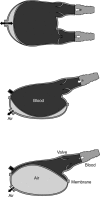Children may survive severe myocarditis with prolonged use of biventricular assist devices
- PMID: 10409544
- PMCID: PMC1729136
- DOI: 10.1136/hrt.82.2.237
Children may survive severe myocarditis with prolonged use of biventricular assist devices
Abstract
The outcome of acute myocarditis with cardiogenic shock is poor. In some children in whom aggressive medical treatment fails, artificial replacement of heart function may offer lifesaving support until the myocardium has recovered. Four previously healthy children (three boys aged 4, 6, and 1 years; one girl aged 5) developed acute myocarditis with ventricular failure and multiorgan dysfunction caused by low cardiac output. Biventricular assist devices (BVAD) were implanted for prolonged support. In three children cardiac function improved and after up to 21 days mechanical support could be withdrawn. They had full recovery of heart function. In the fourth patient there was no myocardial recovery after a period of 20 days. He underwent orthotopic heart transplantation with an uneventful postoperative course. Prolonged circulatory support with BVAD is an effective method for bridging until cardiac recovery or transplantation in children.
Figures




Similar articles
-
Management of acute fulminant myocarditis using circulatory support systems.Artif Organs. 1996 Aug;20(8):964-70. doi: 10.1111/j.1525-1594.1996.tb04579.x. Artif Organs. 1996. PMID: 8853816
-
Acute fulminant myocarditis in children and adolescents: the role of mechanical circulatory assist.ASAIO J. 2006 Mar-Apr;52(2):211-4. doi: 10.1097/01.mat.0000178049.13589.31. ASAIO J. 2006. PMID: 16557111
-
Rapid onset of fulminant myocarditis portends a favourable prognosis and the ability to bridge mechanical circulatory support to recovery.Eur J Cardiothorac Surg. 2013 Feb;43(2):379-82. doi: 10.1093/ejcts/ezs242. Epub 2012 May 7. Eur J Cardiothorac Surg. 2013. PMID: 22564805
-
Mechanical Unloading by Fulminant Myocarditis: LV-IMPELLA, ECMELLA, BI-PELLA, and PROPELLA Concepts.J Cardiovasc Transl Res. 2019 Apr;12(2):116-123. doi: 10.1007/s12265-018-9820-2. Epub 2018 Aug 6. J Cardiovasc Transl Res. 2019. PMID: 30084076 Free PMC article. Review.
-
Mechanical circulatory support for patients with acute-fulminant myocarditis.Ann Thorac Surg. 2001 Mar;71(3 Suppl):S73-6; discussion S82-5. doi: 10.1016/s0003-4975(00)02628-x. Ann Thorac Surg. 2001. PMID: 11265870 Review.
Cited by
-
Immunosuppressive therapy in acute myocarditis: an 18 year systematic review.Arch Dis Child. 2004 Jun;89(6):580-4. doi: 10.1136/adc.2003.034686. Arch Dis Child. 2004. PMID: 15155409 Free PMC article.
-
The role of ventricular assist device in children.Cardiovasc Diagn Ther. 2021 Feb;11(1):193-201. doi: 10.21037/cdt-20-282. Cardiovasc Diagn Ther. 2021. PMID: 33708492 Free PMC article. Review.
-
Current status of paediatric heart, lung, and heart-lung transplantation.Arch Dis Child. 2004 Apr;89(4):386-9. doi: 10.1136/adc.2002.017186. Arch Dis Child. 2004. PMID: 15033856 Free PMC article. Review.
-
Therapy for pediatric myocarditis.Curr Treat Options Cardiovasc Med. 2005 Oct;7(5):411-7. doi: 10.1007/s11936-005-0025-z. Curr Treat Options Cardiovasc Med. 2005. PMID: 16138960
-
Heart failure in the young: Insights into myocardial recovery with ventricular assist device support.Cardiovasc Diagn Ther. 2021 Feb;11(1):148-163. doi: 10.21037/cdt-20-278. Cardiovasc Diagn Ther. 2021. PMID: 33708488 Free PMC article.
Publication types
MeSH terms
LinkOut - more resources
Full Text Sources
